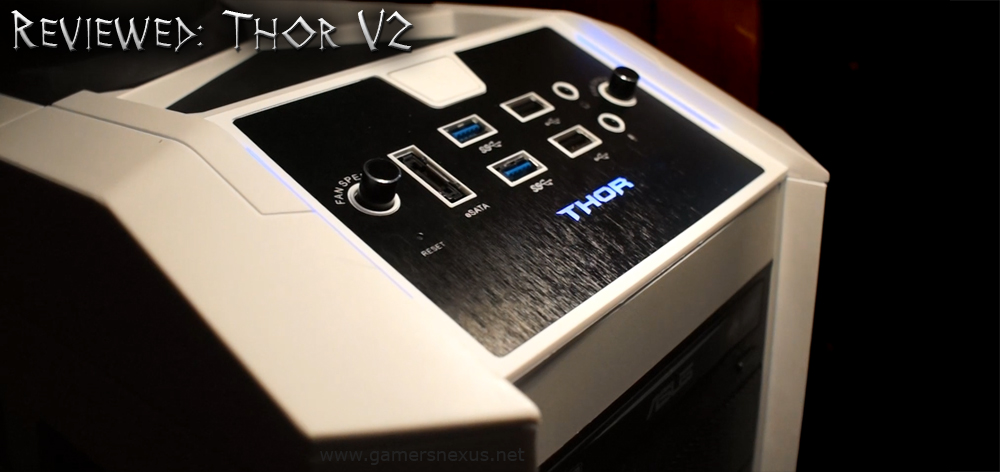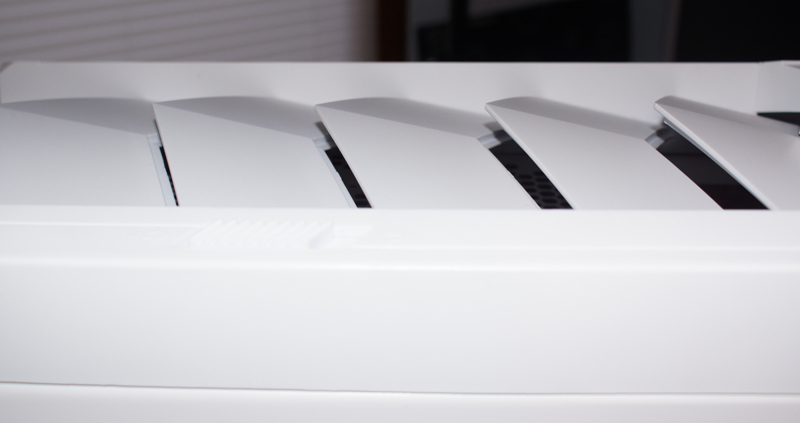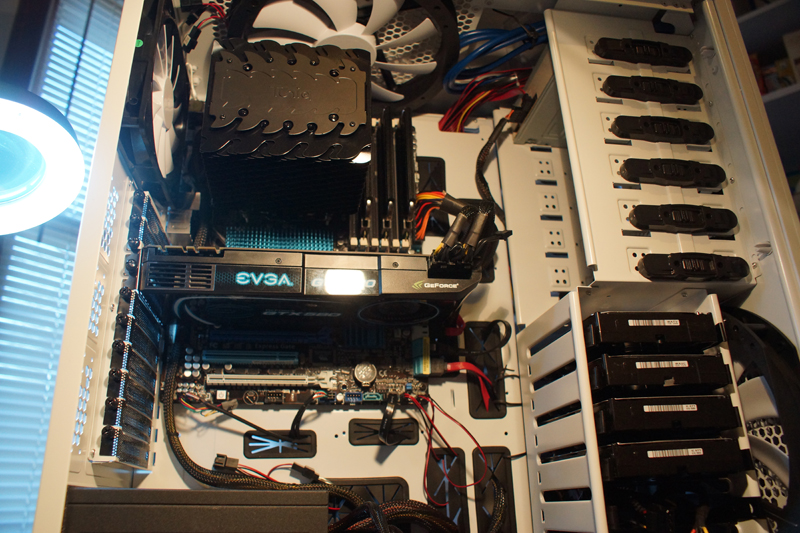Evolutions in PC gaming technology make staggering, industry-driving lunges forward with each passing year; somehow, though, enthusiasts continue to demand increasingly-more from hardware companies as time drones on, and luckily, they're listening.
Or, at least, we think they are. Some of them.
Cooler Master's HAF X has proven to be the premiere case in upper-range gaming over the past years, as its Cosmos had been previously: Its sheer size, feature-set, and cooling ability were insurmountable by other gaming cases for the price. This didn't stop Rosewill, though, who put out their Thor V2 as a more affordable alternative for gamers looking to buy in the $130 range. This review takes a look at the features and functionality of the Thor V2 White Edition case, but for those that aren't fans of white exteriors, there's also a black edition.
Too bad they didn't make a beige edition. Then I could pretend like I'm on the NCC-1701.
Feeling lazy? Here's the video review I did earlier (it has some cool time-lapsed cable management and system assembly, as well):
Specs Overview
| Model | THOR V2-W |
| Type | ATX Full Tower |
| Color | Black |
| Case Material | SECC Steel |
| With Power Supply | No |
| Power Supply Mounted | Bottom |
| Motherboard Compatibility | Micro ATX, ATX, SSI-CEB(E-ATX), XL-ATX |
| With Side Panel Window | No |
| External 5.25" Drive Bays | 6 |
| External 3.5" Drive Bays | 2 |
| Internal 3.5" Drive Bays | 6 |
| Expansion Slots | 10 |
| Front Ports | 2 x USB 3.0 (internal 20-pin connector to MB) 1 x e-SATA 2 x USB 2.0 Audio In/Out(AC97, HD) 2 x Fan speed control knob |
| 140mm Fans | 1 x Rear 140mm Fan |
| 200mm Fans | 1 x Front 230mm White LED Fan(with LED on/off switch) 1 x Top 230mm Fan 1 x Side 230mm Fan |
| Side Air duct | No |
| Dimensions(L x W x H) | 99.14” x 22.84” x 21.89” (WxHxD)(bezel included) 9.14” x 22.84” x 20.08” (WxHxD)(bezel NOT included) |
| Weight | 30.42 lbs. |
| Warranty | 1 year limited |
Features Overview
The Thor V2 on the whole is a chiseled, heavy-set, towering case on the outside, but contains numerous interior features in-tune with its impressive exterior. I did have a few complaints - which you'll read more about below - but the case overall is packed thoroughly with legitimately useful options for any mid-to-upper range gaming rig.
The Thor V2 is as much about fan control as it is about dust control and cable management. Here's a short-hand list of features, which I'll delve into more below:
- Chevron-shaped, toggle-able cooling awning to keep dust out of the system (top).
- Swappable dust filter for the PSU, easily cleanable filter for the bottom-mounted fan.
- 3x230mm fans (front, top, side), 1x140mm fan (rear), and optional add-ons for another 2x140mm fans (top, bottom).
- Plentiful cable management routing pathways.
- Tool-less design.
- Optical drive mounting toggle.
- Sliding HDD bays for easy access.
- 25mm of space behind the motherboard for cable routing.
- Angled front-panel to reduce risk of kicking USB devices.
- 2xFan speed controllers for up to 6 fans.
That's a pretty hefty list, for sure.
Let's hit the most noticeable feature first: As you may have noticed in the photos posted, the case took a page from old Alienware systems by adding an "awning" over the top 230mm fan; this chevron-shaped roof of sorts can be flipped to either an open or closed setting. Closing the awning will majorly invalidate the top fan (and potentially limit your CPU fan's cooling, if it's angled up), but doing so will eliminate dust penetration when using the system in a non-performance environment (or sleeping). The grid should remain open when you're gaming heavily, though, for cooling purposes. This case is all about decreasing casualties of cumulative dust, and despite the dragonspine-esque chevron's cool looks, it does have a purpose. Even when gaming, the interlaced design of the case's roof will help ensure that dust lands only on the cleanable plastic exterior, not in the honeycomb fan mesh.
Adjacent to all of this mechanical goodness is the front panel, which -- thankfully -- is angled in such a way that your knees won't break every USB key you put in it. Not that I've done that. The front panel is adorned with two rotary fan controllers, each attached to cables that can modulate the power fluctuation to up to three fans; two USB 3.0 ports, fitted with the 20-pin header connector for compatible motherboards; and then the normal array of ports: 2xUSB2.0, 2xAudio (I/O), and an eSATA connector.
Oh, and the word 'Thor' lights up white. That's gotta be worth mentioning as well, right?
Sliding down the front of the case, we brush past the external drive bays and dangerously-easy-to-remove front-right panel. This is both a terrifying and an intriguing feature: By simply pushing on the right (facing the case) ridge, you'll pop it out of location and be able to rapidly swap out drive bay coverings and devices. Unfortunately, due to the unwieldy nature of these larger cases, that's also a natural location to grab it when moving it from, say, your table - which rests four feet in the air - to your floor. Your wood floor. Your expensive wood floor.
I think you see where this is going.
When I naturally reached for a grip and landed on the removable front/side plating, it slid off with rapidity and flew to the floor, leaving me scrambling to catch the system. Luckily, I min/maxed dexterity, apparently, so I was able to catch the case.
Does this really take off many points? Not really. It's tough to position grabbing locations on these monstrous cases, anyway, and the accessibility is much appreciated over the potential detriments. Besides, how often will you move your case, anyway?
Oh - one last thing on the front: Slightly below the front/side panel is a hidden compartment, which houses a tiny button (Spot check DC18); some say this button is capable of wreaking irreparable devastation upon the universe.
That's why I pushed it. I like to live on the edge.
It turned on a white LED on the front 230mm fan. Although it isn't very bright, its nighttime luminance has a nice glow to it. This is neither positive nor negative: If you like bright fans, well, that sucks - you'll need to find another fan or live with this relatively dim one; if you can't stand LEDs, then you're given an option to disable it and also a low-brightness option. Personally, I'd prefer a much more vibrant LED - probably on the other fans as well - but that's just aesthetic.
Performance & Cable Management
Cable routing is where the Thor V2 really shines. For this review and testing setup, I transplanted my (rather large) configuration from my HAF X into the Thor V2 - I run a non-modular, high-end power supply for test rigs, so that means I have a lot of cables that don't necessarily go to anything, and I can't easily remove. To hide these on the HAF X requires the hands of a mouse and access to the town wizard. The Thor V2, on the other hand, has more rubber-clothed pass-throughs than I knew what to do with -- I think Rosewill understands that there's not much point to having more locations to 'deposit' cables than withdraw them (and vice versa), and so they've made sure to accommodate cables by strategically cutting out holes throughout the mid-section. This makes cable stuffing, hiding, and overall management exceedingly easy - and for that reason, if you're a new builder or untrained in cable management, I highly recommend either the Thor V2's setup or one similar to it.
Properly managed cables will help encourage further dust prevention and reduce risk of obstructed airflow patterns in the case, which - of course - would be a detriment to performance.
With the stock fans installed and a carefully managed system, I found the Thor V2 case temps to run at about 5-7C higher than my tricked-out HAF X, with the GPU temperature sitting only 2C higher in the Thor V2. That's quite impressive, considering I was running stock fans and the Thor V2 is significantly cheaper. I wish the fan expansion options were a bit more robust and diverse, but the bottom-mounted 140mm fan expansion is a great start. The additional top-fan mounting location would be the last I'd include, since it sits right above drive bays and will not be cooling all that much.
When adjusting the fan speed controllers on the front panel (they modulate power allowance to the connected fans), I found that dialing them all the way down retained a level of coolness that was admirable for normal, non-performance computing. This same low level of fan speed kept things very quiet, leaving only my noisy CPU fan to make a lot of racket. It's definitely a good option for quiet gaming, if that's important to you. I wrote a fairly extensive guide on quieter gaming here and followed it up with a bearing technology guide.
Build Quality
I noted in the above video review that I felt the case was overall solid quality: It uses good, firm plastics and metals - for the most part - and has no common indicators of a lower-class case (shiny, flimsy plastic, as an example, is always a concern). The Thor V2 has a few weak points: The insta-screw feature for mounting optical drives is fragile and easy to push in the wrong way, so be careful with that, and the removable / cleanable dust filter is tricky to line up properly, but otherwise bragworthy. Native cooling ability isn't quite what I'd like it to be, but again - at the price-point, it's tough to dispute the Thor's potential for dominance.
Build quality is never easy to explain since it's very based in personal experiences: The case feels right -- repeat system builders know what I mean -- it's not using cheap, destructible plastic.
Value
It's very challenging to find something to complain about for this case. It's good - simple as that. The Thor V2 offers an impressive array of features and makes the job of a first-time builder easy, and at ~$130, you really can't beat that with much else. Other cases in this price range to consider would be the NZXT Phantom, HAF 932, AzzA Solano 1000, and In Win Dragon Rider.
The bottom line is clear to me: Enthusiasts that are working on systems in the $1500 range should probably look for a higher performance, slightly higher-budget case; newcomers to PC builds -- including those that make use of our PC build guides -- will want to seriously consider the Thor V2 for its performance-to-price ratio. Anyone that's in the $700-$1000 range should keep this on their radar, along with the cases mentioned above.
Check out the Thor V2 here: http://www.rosewill.com/products/1936/ProductDetail_Overview.htm
-Steve


